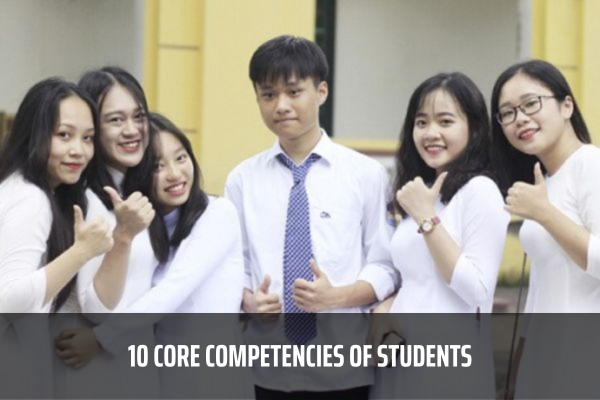What are core competencies of students? What are the requirements to achieve the specific competence requirements for students in Vietnam?
What are 10 core competencies of students in Vietnam?
Pursuant to the regulations in the General Education Program issued with Circular 32/2018/TT-BGDDT, 10 core competencies of students are as follows:
The 10 core competencies of students include:
- General competencies:
- Self-management and self-learning skills
- Communication and collaboration skills
- Problem-solving and creativity skills
- Specific competencies:
- Language skills
- Mathematical skills
- Scientific skills
- Technological skills
- Computer skills
- Aesthetic skills
- Physical skills

What are 10 core competencies of students? What are the requirements to achieve the specific competence requirements for students in Vietnam? (Image from the Internet)
What are the required achievements of self-reliance and self-learning abilities for upper secondary school students in Vietnam?
Pursuant to the regulations in the General Education Program issued with Circular 32/2018/TT-BGDDT, the required achievements of self-reliance and self-learning abilities for upper secondary school students are as follows:
- Self-reliance:
Always proactive and actively engage in their own learning and life tasks; know how to help others rise up to lead a self-reliant life.
- Self-assertion and protection of rights and legitimate needs:
Know how to assert and protect their rights and legitimate needs in accordance with ethics and laws.
- Self-regulation of emotions, attitudes, and behaviors:
+ Assess the strengths and limitations of their own emotions and feelings; be confident and optimistic.
+ Know how to regulate their own emotions, attitudes, and behaviors; remain calm and behave appropriately.
+ Be ready to accept and overcome challenges in learning and life.
+ Know how to avoid social vices.
- Adaptation to life:
+ Adjust their knowledge, skills, and experiences to new activities and living environments.
+ Change their mindset, expression of attitudes, and emotions to meet new demands and circumstances.
- Career orientation:
+ Recognize their own personality and values.
+ Understand the main information about the labor market, requirements, and prospects of different professions.
+ Determine a suitable development direction after upper secondary school; make plans and choose subjects that align with their career orientation.
- Self-learning and self-improvement:
+ Identify learning tasks based on the achieved results; set detailed, specific learning goals and overcome limitations.
+ Evaluate and adjust learning plans; develop their own learning methods; search, evaluate, and choose appropriate learning materials for different learning purposes; take notes in suitable forms for memorization, use, and supplementation when necessary.
+ Recognize and adjust their own mistakes and limitations in the learning process; reflect on their learning methods, draw lessons to apply in different situations; know how to adjust their learning methods.
+ Engage in self-nurturing regularly based on personal striving goals and civic values
What are the requirements to achieve the specific competence requirements for students in Vietnam?
Pursuant to the regulations in the General Education Program issued with Circular 32/2018/TT-BGDDT, the specific competence requirements for students are as follows:
(1) Language competence
- Language competence of students includes the ability to use Vietnamese and foreign languages, which are demonstrated through listening, speaking, reading, and writing activities.
- The language competence requirements for each grade level are specified in the Vietnamese Language curriculum, Foreign Language curriculum, and are implemented in all subjects and educational activities, in accordance with the characteristics of each subject and educational activity. Vietnamese Language and Foreign Language are the main subjects.
(2) Mathematical competence
Mathematical competence of students is demonstrated through the following activities:
- Awareness of mathematical knowledge;
- Mathematical thinking;
- Application of learned knowledge and skills.
Mathematical competence is developed in various subjects and educational activities, in accordance with the characteristics of each subject and educational activity. The most focused expression of mathematical competence is mathematical ability, which is primarily developed in the subject of Mathematics. The mathematical competence requirements for each grade level are specified in the Mathematics curriculum.
(3) Scientific competence
Scientific competence of students is demonstrated through the following activities:
- Scientific awareness;
- Natural and social exploration;
- Application of learned knowledge and skills.
Scientific competence is developed in various subjects and educational activities, in accordance with the characteristics of each subject and educational activity. The main subjects are Natural and Social Sciences, Science, History, and Geography (in primary education); Natural Sciences, History, and Geography (in lower secondary education); Physics, Chemistry, Biology, History, Geography, Economics and Law Education (in upper secondary education). Each subject's curriculum and educational activities help students continue to develop scientific competence with increasing depth through different grade levels (scientific competence; natural science competence, social science competence; physics competence, chemistry competence, biology competence; history and geography competence, history competence, geography competence).
The scientific competence requirements for each grade level are specified in the Natural and Social Sciences, Science, History, and Geography curriculum (in primary education); Natural Sciences, History, and Geography curriculum (in lower secondary education); Physics, Chemistry, Biology, History, Geography, Economics and Law Education curriculum (in upper secondary education).
(4) Technological competence
Technological competence of students is demonstrated through the following activities:
- Technological awareness;
- Technological communication;
- Technological use;
- Technological evaluation;
- Technical design.
The technological competence requirements for each grade level are specified in the Technology curriculum and are implemented in various subjects and educational activities, in accordance with the characteristics of each subject and educational activity. Technology is the main subject.
(5) Computer literacy
Computer literacy of students is demonstrated through the following activities:
- Use and manage information and communication technology tools;
- Appropriate behavior in a digital environment;
- Problem-solving with the support of information and communication technology;
- Application of information and communication technology in learning and self-study;
- Collaboration in a digital environment.
The computer literacy requirements for each grade level are specified in the Computer curriculum and are implemented in all subjects and educational activities, in accordance with the characteristics of each subject and educational activity. Computer is the main subject.
(6) Aesthetic competence
Aesthetic competence of students includes music competence, art competence, and literature competence, which are demonstrated through the following activities:
- Awareness of aesthetic elements;
- Analysis and evaluation of aesthetic elements;
- Reproduction, creation, and application of aesthetic elements.
The aesthetic competence requirements for each grade level are specified in the Music, Art, and Literature curriculum and are implemented in various subjects and educational activities, in accordance with the characteristics of each subject and educational activity. The three subjects mentioned above are the main subjects.
(7) Physical competence
Physical competence of students is demonstrated through the following activities:
- Health care;
- Fundamental movement skills;
- Physical education and sports activities.
The physical competence requirements for each grade level are specified in the Physical Education curriculum and are implemented in various subjects and educational activities, in accordance with the characteristics of each subject and educational activity. Physical Education is the main subject.
LawNet
